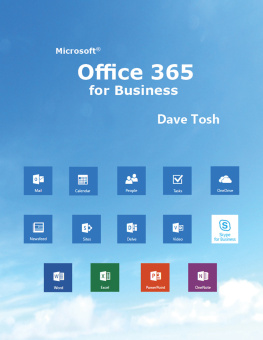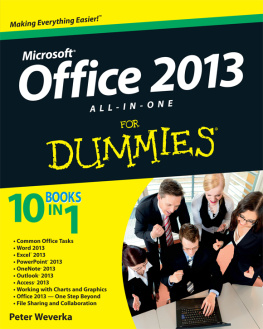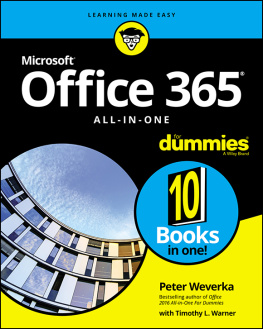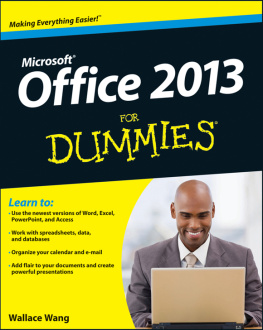Microsoft Office 2016: The Complete Guide
Copyright 2015.
All are rights reserved.
This book or any portion thereof may not be reproduced or used in any manner whatsoever without the express written permission of the publisher except for the use of brief quotations in a book review.
IDENTIFYING NEW FEATURES OF WORD 2016
Tell Me Command
The new feature Tell Me what you want to do finds tools on the ribbon easily. This tool is especially great for new users to Word; it allows the user to type words and phrases about the actions they would like to take next. It is quite efficient in taking you to features that you are most likely to use. In addition, it will also help you find actions you want to perform. Tell Me is quite efficient in finding tools, thereby saving you time and effort. When you type in your key word, tell me will provide you with shortcuts to some of the possible options.
To use the new feature Tell me:
Type your Search criteria in the Tell Me Box at the top of your ribbon.
While you are typing, some possible Results will be displayed.
For instance, if you are desirous of indenting your document, simply type indentation and Tell Me will bring back the Insert Indentation commands.
You can view previous commands in Tell me:
Click in the Tell Me box.
The Recently Used drop-down listing will appear.
You will see the last five commands displayed that you have performed from within Tell Me.
Real Time Team Work
You can collaborate on a document with Word 2016 or Word Online. You may work simultaneously with your colleague whom you can share the document with. Furthermore, both you and your colleague can see changes that are made by each other to the document. You can also see the position of the cursor on the document where the changes are being made. It should be noted that both users will need to be operating Office 2016 Preview. Editing permission should also be given to the person you want to share the document with. Therefore, each user will need to agree to share changes in order to view work in real time.
In order to opt in to real-time co-authoring:
Access a Document stored on OneDrive for Business or on SharePoint Online.
Choose Yes to share changes that you have made.
Smart Lookup
Smart Lookup provides you with insights by giving you the option of researching a word or phrase. To use Smart Look:
Choose the Word or Phrase, you would like to find information on.
Right-click on the Word or Expression.
Choose the Arrow at the right edge of the moving toolbar.
A menu will be displayed.
Select Smart Lookup.
Locate the Ribbon.
Choose Smart Look up on the Review table.
You will see the Insight pane displaying information pertaining to your search.
Ink Equations
Your math equations are so much simpler with the new ink equations. To use this function to aid you with challenging maths equations:
Locate Insert.
Click on Equation.
Click on Ink Equation.
However, you can use a touch stylus or your fingers to write the maths equation and Word 2016 will change it to text. You also have the option of correcting the equation where necessary during the process.
Improved Version History
Users will now be able to view a history of all the changes they have made to their documents. Moreover, users will also have access to earlier versions of their documents. If you desire to open a previous version:
Select the File tab.
Choose History.
Select the version you desire to restore in the History pane.
Simpler Sharing
Users can now share their document with their colleagues on SharePoint, One-Drive, or One-Drive for Business. Simplified sharing allows you to quickly invite others to review or edit your documents. You can save your file to the cloud and make it available to others without having to navigate from your work.
To share your file:
Choose Share (above the ribbon that is located on the right side).
Select Save (if the document was previously stored on the cloud).
Choose Save As.
Select the Target folder on the right.
Invite Other persons.
Determine if they can Edit or only View files.
Improved Shape Formatting
User can now get the look they desire with the Shapes gallery. Users are now able to quickly choose from a variety of preset fill and theme color to enhance the appearance of their shapes.
WORKING IN THE WORD 2016 USER INTERFACE
Microsoft Office interface provides an easy and simple way to work with Office documents. These documents comprise of Microsoft Word documents, PowerPoint presentations, Excel workbooks, Access database tables and Outlook email messages.
In order to start Word, you may do so from the Start screen or you may opt to do so from the Start Menu which is shown when you tap on the left end of the Windows Taskbar. However, if Word is opened directly a program starting screen will be displayed. At this point you can choose to create an original document or you may open a document that already exists. Irrespective of the route that is used, you will find all the program windows that are required to add and format your content.
Your New Documents
There are several ways to create a new document. You may decide to create a brand-new or a blank document, a template or use an existing document. If you are creating a blank document:
Choose the File tab.
Select New.
The New tab will be displayed.
It should be noted that when you first start Word, the New tab opens on the right by default.
If you are using a built-in template:
Choose the File tab.
Choose New.
Select one of the Template that is listed.
The template will then open.
If you are using a Custom template:
Choose the File tab.
Identifying Program Window Elements
In the program window, you will find the undermentioned elements:
Title
Ribbon
The Title Bar
At the top of the Word interface is the Title Bar that is present on all windows application to remind you of the program you are using. It also contains the name of the document you are currently using. You can also use the title bar to do a variety of things, for example, minimize, resize or close the document. These three icons are positioned in the top right hand corner. The icon that is used to minimize the document is similar to this symbol (_). The icons that are used to resize appear as one or two squares based on how the document appears. Additionally, the icon that is used to close the document is represented by an X usually denoted in red.
The Ribbon
The Ribbon is located below the title bar. This consists of all the commands that are necessary for working and navigating in a Word document. From the ribbon, you can explore the Home tab, the Insert tab and the Design tab. The Home tab allows you to add bullets or numbering to text, you can align text and also adjust the space between each line. The Home tab is widely used by Word. The Insert tab allows you to insert your pictures and tables to engage your readers. You can also add headers and footers to your document. With the design tab you have the option of determining how your document looks.
OPENING, NAVIGATING, AND CLOSING DOCUMENTS
In cases where Word is not active, you may start Word and also open an existing document at the same time.
To start Word and also open an existing document at the same time:
Double-click the Documents file name.
In cases where Word is already active, from the start page, you should choose an existing Document, located in the Recent pane.
Create a New document from the template, or
Tap on Open Other documents to reveal the Back stage view.










